Knowing that I’m always interested in Custer stuff, Brenda bought me the book “Exploring with Custer”, an amazing chronicle of the Black Hills expedition. It details each day’s travel, with maps, photos, and reprinted reports written by the expedition members, including the five reporters who traveled as guests of Custer. It has a section of unique photos, where on one page is the black and white photo taken by the expedition photographer, and on the facing page a color photo taken recently – in the same location. The differences are intriguing; most notably that the landscape today is much more forested than in the 1870s, thanks to fire management practices. But the real reason for the book is the ability to follow in Custer’s footsteps as he explored, and so off we went!
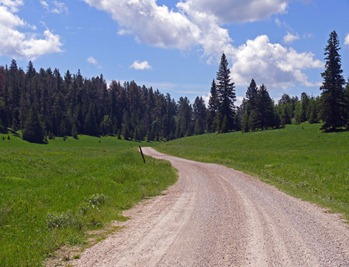 We picked up the Custer route on a forest service road just outside of the former town of Buckhorn, on the Western edge of the Black Hills. In this area, gravel forest service roads follow the same route as the expedition, since the terrain follows a series of valleys. It’s a beautiful area, described by one reporter as an “exquisite site of park-like scenery”. At our starting point, we were at “Floral Valley, the site where on July 25th, 1874 Custer wrote:
We picked up the Custer route on a forest service road just outside of the former town of Buckhorn, on the Western edge of the Black Hills. In this area, gravel forest service roads follow the same route as the expedition, since the terrain follows a series of valleys. It’s a beautiful area, described by one reporter as an “exquisite site of park-like scenery”. At our starting point, we were at “Floral Valley, the site where on July 25th, 1874 Custer wrote: “Its equal I have never seen. Every step of our march that day was amid flowers of the most exquisite colors and perfume. So luxuriant in growth were they that men plucked them without dismounting from the saddle.... It was a strange sight to glance back at the advancing columns of cavalry, and behold the men with beautiful bouquets in their hands, while the head-gear of the horses was decorated with wreaths of flowers fit to crown a queen of May. “
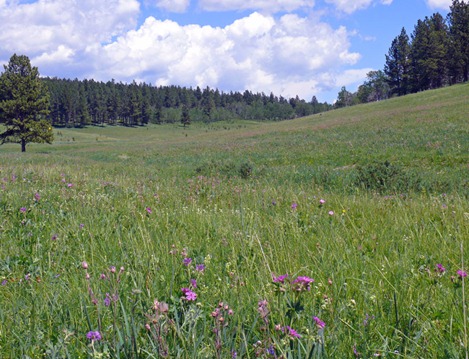
An interesting mental picture, isn’t it? But seeing the valley at about the same time of year, we could see why his men were so taken with the wildflowers covering the bright green valley.

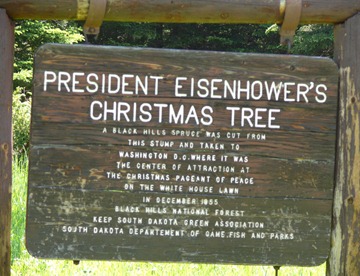 We came across this interesting sign along the route, tucked into the edge of the forest. It’s been a long time since the tree was harvested; we couldn’t even find the stump!
We came across this interesting sign along the route, tucked into the edge of the forest. It’s been a long time since the tree was harvested; we couldn’t even find the stump!After a couple of hours, we reached Deerfield Lake, a Custer campsite now covered by a reservoir. Our two hour trip took Custer and his expedition about four days!
Departing from the Custer route, we drove over the the town of Custer, to view it’s museum. On the way, we had this interesting view of the Chief Crazy Horse Memorial.
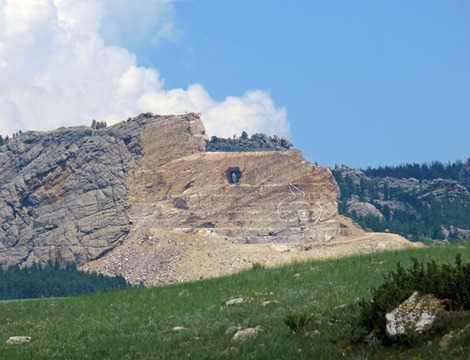
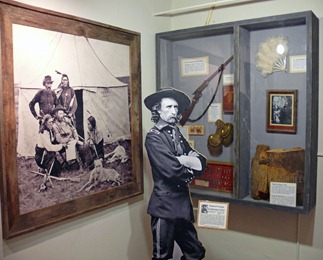 The Custer County Courthouse Museum is in a pretty building, and the museum was nice, but nothing exceptional. The one area we particularly enjoyed was the small section with memorabilia from Custer’s visit – in fact it looked like he was really standing there.
The Custer County Courthouse Museum is in a pretty building, and the museum was nice, but nothing exceptional. The one area we particularly enjoyed was the small section with memorabilia from Custer’s visit – in fact it looked like he was really standing there.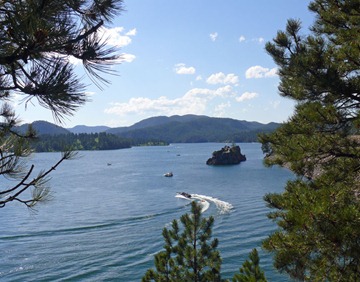 On the way back to Spearfish, we stopped at Pactola Lake, a large lake in the heart of the Black Hills. It was a hot day, and the lake was crowded with skiers. It wasn’t long ago (May) that the lake still had a coating of ice – it made us wonder how warm the water could be.
On the way back to Spearfish, we stopped at Pactola Lake, a large lake in the heart of the Black Hills. It was a hot day, and the lake was crowded with skiers. It wasn’t long ago (May) that the lake still had a coating of ice – it made us wonder how warm the water could be.That’s it for this trip – C’mon back, like Custer, we’re exploring the Black Hills!